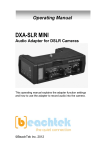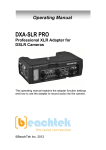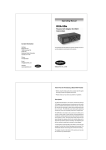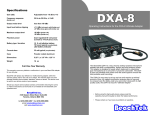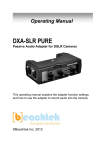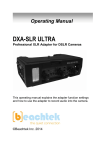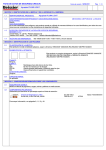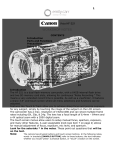Download BeachTek DXA-CONNECT Setup guide
Transcript
Operating Manual DXA-CONNECT Professional XLR Adapter for DSLR Cameras and Camcorders This operating manual explains the adapter function settings and how to use the adapter to record audio into the camera. ©Beachtek Inc. 2013 Thank You for Purchasing a Beachtek Product Congratulations on purchasing the most versatile audio adapter for DSLR cameras and camcorders. This adapter makes it easy to mount and connect a wide variety of audio gear to your camera to record professional sound. Before using this high quality device, please read this guide thoroughly to obtain the highest performance. Please contact us if you have any problems or questions. Description The Beachtek DXA-CONNECT is a two-channel, active XLR adapter with built-in preamplifiers for attaching external microphones and other audio gear to any camera or camcorder that has a built-in mic jack. It is also ideal for recording very high quality audio directly to a field recorder like the Atomos Ninja 2. The DXA-CONNECT uses exceptionally low noise, wide bandwidth preamplifiers for superb audio. This allows you to record high quality audio directly to the camera, which will always be in sync with the video. Direct audio recording eliminates the need to have a separate audio recording device and syncing the audio in post editing. The DXA-CONNECT is very easy to set up and use. It allows you to connect a wide variety of audio devices including wireless systems, mixers, sound boards and professional condenser microphones that require phantom power to operate. A unique feature of the DXA-CONNECT are the integrated mounting shoes, which allow you to attach a wide variety of gear such as monitors, lights, mics and wireless to your camera. The adapter mounts to the hot shoe of the camera. Warnings Ensure that the VOLUME control is set low to avoid excessively loud audio damaging your hearing. Always do a test recording and play back the audio to ensure it is acceptable. DO NOT activate phantom power for dynamic microphones, condenser microphones that do not operate on phantom power, wireless receivers, mixing boards or any unbalanced device as it may cause damage to both the adapter and connecting device. Turn off power to adapter before plugging or unplugging any microphones or equipment to or from the adapter. Contents Before You Begin……………………………………………………….. Supplied Accessories…………………………………………………... Quick Setup Guide……………………………………………………… Adapter Connectors and Controls…………………………………….. Setup Guide……………………………………………………………... Basic Operation…………………………………………………………. Features…………………………………………………………………. Specifications…………………………………………………………… Warranty Information…………………………………………………… 1 1 2 4 6 9 10 11 12 Before You Begin 1) This product is primarily designed for cameras that have manual audio controls to get the best performance and a headphone jack to monitor the sound. This includes the Canon 5D MKIII and Nikon D800. 2) Panasonic Lumix GH1 and GH2 DSLR cameras require a special 2.5mm mic cable which is available from our Online Store. Supplied Accessories 3.5mm to 3.5mm output cable 1 Quick Setup Guide 1) Ensure the POWER switch is set to OFF before you begin. 2) Install a fresh alkaline or lithium battery in the adapter. 3) Mount the DXA-CONNECT adapter to the camera hot shoe. 4) Connect the supplied output cable from the OUT jack on the adapter to the MIC input jack on the camera. 5) Set the camera gain to between the lowest setting and 25% of maximum. 6) Connect your microphones or other audio sources to the adapter XLR inputs. 7) Set the GAIN switches to +20dB. 8) Set the PH switches to ON only for condenser type mics that require phantom power to operate. DO NOT activate phantom power when attaching wireless microphones! 9) Set the PH VOLTAGE switch as follows: a. OFF if no phantom is being used on either channel b. 48V if either channel requires 48 volt phantom c. 12V if the mics can operate on 12 volts to save on battery power 10) Set the M/S switch to M for mono when using one channel or to S for stereo when using two channels. 2 11) Turn the adapter PWR switch ON. The power LED should indicate green. 12) Adjust the LEFT and RIGHT level controls for each channel to get an average reading of -12dB on the VU Meter in the camera. 13) Plug your headphones into the phone jack on the camera and adjust the volume control to a comfortable level. Ensure that you hear audio on both channels from the connected devices. 14) Do a test recording and playback on the camera to ensure that the captured audio is satisfactory. 3 Adapter Connectors and Controls Control Panel 1 PWR Switch Main power switch for adapter 2 PWR LED Green indicates power on and good battery condition Red indicates low battery voltage 3 M/S Switch Selects mono (mixed) or stereo (separated) output mode 4 LEFT and RIGHT Controls Individual adjustment controls to adjust output levels on each channel 5 Gain Switch Select 0dB for low, +20dB for med, and +30dB for high gain 6 PH Switch Turns phantom power on or off for each channel 7 12V/OFF/48V Switch Select OFF, 12V or 48V Phantom power for condenser microphones that require phantom power to operate Control Panel 4 7 3 6 5 2 1 4 1 Connector Panel 8 LEFT and RIGHT XLR Inputs Two balanced XLR inputs attach to professional microphones or other audio gear such as wireless systems or mixers and sound boards 9 OUT Output jack for connection to the camera 3 Connector Panel 8 9 5 Setup Guide Battery Installation 1) The DXA-CONNECT operates on one 9 volt battery. We recommend that you use either an alkaline or lithium type battery for the longest operating time. 2) To install the battery, unlatch the drawer by pushing in and over on the drawer front, releasing and sliding the drawer out. Insert the battery with the “+” positive terminal lined up with the “+” indicator on the battery compartment. Slide the battery drawer closed until it clicks into place. Mounting and Connecting the Adapter to the Camera 1) Ensure that the camera and adapter are both switched off. 2) Slide the adapter onto the hot shoe of the camera and lock in place. Can also be mounted to any other device or rig that accepts a standard shoe mount. 3) Connect one end of the supplied output cable to the OUT of the adapter and the other end to the MIC on the camera. 6 Initial Setup Connect your microphones or other audio gear to the adapter via the XLR inputs. Set the PH switches to on only for condenser type mics that require phantom power to operate. DO NOT activate phantom power when attaching wireless microphones! Set the PH VOLTAGE switch as follows: a. OFF if no phantom is being used on either channel b. 48V if either channel requires 48 volt phantom c. 12V if the mics can operate on 12 volts to save on battery power Set the GAIN switch to +20dB as an initial setting. You should monitor the VU Meter in the camera to see if you need to lower or raise the gain depending on what mics you are using and the gain setting of the camera. Set the M/S switch to M for mono when using one microphone. Set the unused channel level control fully counter-clockwise to 0 to disable it to prevent noise. When using two microphones, you should normally set the switch to S for stereo to keep each channel separated. Set the LEFT and RIGHT level controls fully counter-clockwise to 0. Plug your headphones into the phone jack on the camera to monitor the audio. Ensure that the volume control is set low to avoid excessively loud audio damaging your hearing. 7 Camera setup The Auto Gain Control (AGC) in the camera will vary the amount of gain depending upon the input signal level. During quiet moments, the AGC will increase the gain, which will also increase the amount of hiss from the camera preamplifiers. If your camera allows you to disable the AGC feature, we recommend that you do so to get the best performance. Set the camera to manual mode and the camera gain to between the lowest setting and 25% of maximum. Generally, the lower you set the gain in the camera, the better your signal to noise ratio will be. 8 Basic Operation After following the above Initial Setup, you should be ready to start recording. 1) Turn the adapter PWR switch ON. The power LED should light green, indicating good battery voltage. Red indicates low battery warning. 2) Turn on the camera and set to record standby. 3) Adjust the LEFT and RIGHT level controls to give you an average reading of about -12dB on the VU Meter in the camera. This will provide a good signal level to the camera and still offer plenty of headroom for higher transient signals. You may need to change the gain settings on the adapter and camera to achieve the proper recording levels. As a general rule, you want to maximize the gain in the adapter to take advantage of the low noise preamps and minimize the gain of the camera for the best results. 4) Do a test recording and then play back the audio from the camera to determine if the captured audio is acceptable. Notes on Getting the Best Audio Performance The most common problem in recording professional audio on today’s DSLR cameras is the hiss generated by the camera preamplifiers. You will never completely eliminate all hiss, which is normal, but you can reduce it so that it is no longer a problem. The most important thing to remember when recording audio is to set the audio levels correctly as explained in this manual. Setting the levels too low will give you a poor signal to noise ratio and lead to poor results. Also, setting the levels too high will cause clipping and distortion. Having the proper levels will ensure that good clean audio signals are being sent to the camera for the highest quality audio. You should use a quality professional microphone, and proper mic placement and techniques for optimum results. 9 Features Inputs Two balanced XLR connectors Outputs Unbalanced stereo mini-plug jack for connection to the camera Phantom Power Switchable 12V/48V phantom power for both channels Gain Switch 0dB, +20dB, and +30dB gain setting for each channel Level Controls Adjusts signal level output on each channel Low Noise Preamplifiers Exceptionally low noise circuitry for superb audio Wide-bandwidth for full rich sound Power Easily replaceable 9 volt battery Low battery indicator Case Sturdy extruded aluminum enclosure 10 Specifications Maximum Input Levels +13 dBu -7 dBu -17 dBu at 0dB gain setting at 20dB gain setting at +30dB gain setting Output Level Nominal MIC levels Frequency Response 20 Hz to 20 kHz (+/- 0.5 dB) THD Less than 0.01% @ 1 kHz, -30 dBu input S/N Ratio 85 dB @ 1 KHz, -30 dBu input Gain Low 0 dB Med +20 dB High +30 dB Phantom Power Dual regulated 12 or 48 volt power supplies Current to 14 mA (direct short) Battery Type One 9 volt alkaline or lithium battery Battery Duration 3 hours typical with alkaline battery (no phantom) 8 hours typical with lithium battery (no phantom) Dimensions 6” x 2.5” x 3.25” (L x W x H) (152 mm x 63 mm x 82 mm) Weight 18 oz (0.51 kg) This device complies with the FCC Rules, Part 15, Class B 11 Warranty Information Limited Two Year Warranty This warranty covers any defects or malfunction in your new Beachtek adapter for two years from date of purchase. Beachtek will replace or repair any defective or malfunctioning adapter, within the warranty period, at no charge. The warranty does not cover damage resulting from accident, alteration, misuse or abuse. The device must be sent to our service center at your expense. Should you require service please contact us first before returning the unit to us. Return instructions can be found on our website at www.beachtek.com under the Support option. Upon receiving the returned adapter it will be inspected and replaced or repaired if found defective. The unit will be shipped back to you within five business days at our expense. 12 Contact Information Address Beachtek Inc. 480 Osprey Avenue Kelowna, British Columbia Canada V1Y 5A5 Phone 778-478-9872 Email [email protected] Website www.beachtek.com




















